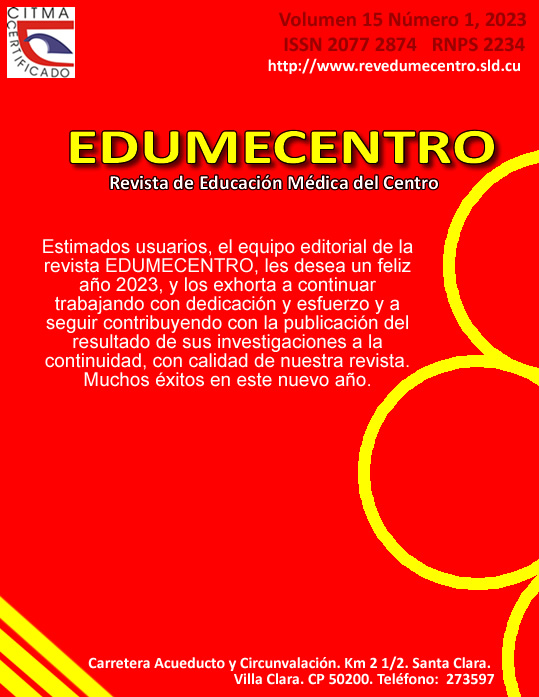Academic stress in Nursing students during the pandemic: challenges, coping, immediate perspectives
Keywords:
stress, physiological, pandemics, technology, education, medical, students, nursingAbstract
Introduction: COVID-19 has been a considerable challenge to obtain high-quality training for students in the Nursing area because universities continued with norms, outdated strategies that did not respond to changes. Objective: to analyse the characteristics of academic stress in Nursing students during the teaching-learning process in times of the COVID-19 pandemic.
Methods: a systematic bibliographic review was carried out to develop a reflective critical analysis on the content of the bibliographies, with a documentary search based on the 32 previously selected original scientific articles, publications in English, Spanish and Portuguese in the Scopus databases, Pubmed, Dialnet, Scielo, Elsevier, Latindex, and Web of Science. The keywords used were stress, academy, resilience, pandemic, and virtual teaching.
Development: the change from the face-to-face to the virtual environment caused a significant shift in the development of the teaching-learning mode, generating stress, for which reason care protocols for students must be managed.
Conclusions: the academy was surprised by the pandemic, as it happened with the general population. Not enough strategies were articulated to be able to face the different situations that generated academic stress. Resilience needs to be addressed for all health eventualities.
Downloads
References
1. Comisión Económica para América Latina y el Caribe [CEPAL]. (2020). La educación en tiempos de la pandemia de COVID-19. UNESCO. 2020. [citado junio 2022]. Disponible en:https://www.cepal.org/es/publicaciones/45904-la-educacion-tiempos-lapandemia-covid-19covid-19
2. Estrada, E; Mamani, M; Gallegos, N; Mamani, H y Zuloaga, M. Estrés académico en estudiantes universitarios peruanos en tiempos de la pandemia del COVID-19. Archivos Venezolanos de Farmacología y Terapéutica. 2021. [citado junio 2022]; 40 (1). Disponible en: https://www.revistaavft.com/images/revistas/2021/avft_1_2021/16_estres_academico_estudiantes.pdf
3. Keefe, R y Auffermann, K. Exploring the Effect of COVID-19 on Graduate Nursing Education. Academic medicine: journal of the Association of American Medical Colleges. 2022. [citado junio 2022]; 97 (3). Disponible en: https://www.ncbi.nlm.nih.gov/pmc/articles/PMC8855768/
4. Leaver, C; Stanley, J y Goodwin, T. (2022). Impact of the COVID-19 Pandemic on the Future of Nursing Education. Academic medicine: journal of the Association of American Medical Colleges. 2022. [citado junio 2022]; 97 (3). Disponible en: https://www.ncbi.nlm.nih.gov/pmc/articles/PMC8855777/
5. Espinoza, A: Pernas, I y González, R. Consideraciones teórico metodológicas y prácticas acerca del estrés. Humanidades Médicas. 2018. [citado junio 2022]; 18 (3). Disponible en: http://scielo.sld.cu/scielo.php?script=sci_arttext&pid=S1727-81202018000300697
6. Vizoso, C y Arias, O. Estresores académicos percibidos por estudiantes universitarios y su relación con el burnout y el rendimiento académicos. Anuario de Psicología. 2016. [citado junio 2022]; 46 (2). Disponible en: https://www.sciencedirect.com/science/article/abs/pii/S0066512616300125
7. Alfonso, B; Calcines, M; Monteagudo, R y Nieves, Z. (2015). Estrés académico. Edumecentro. 2015. [citado junio 2022]; 7 (2). Disponible en: https://dialnet.unirioja.es/servlet/articulo?codigo=5023824
8. Hernández, R; Fernández, C y Baptista, P. Metodología de la investigación. México. McGRAW-HILL. 2014. [citado junio 2022]; Disponible en: https://www.uca.ac.cr/wpcontent/uploads/2017/10/Investigacion.pdf
9. Otzen, T y Manterola, C. Técnicas de Muestreo sobre una población a estudio. International Journal of Morphology. 2017. [citado junio 2022]; 35 (1): 227-232. Disponible en: https://scielo.conicyt.cl/pdf/ijmorphol/v35n1/art37.pdf
10. Aslan, H y Pekince, H. Nursing students' views on the COVID‐19 pandemic and their percieved stress levels. Perspectives in Psychiatric Care. 2020. [citado julio 2022]; 57. Disponible en: https://onlinelibrary.wiley.com/doi/epdf/10.1111/ppc.12597?src=getftr
11. March, J; Cambra, I; Casas, J; Altarriba, C; Comella, A; Pujol, R; Baños, J; Galbany, P y Comella, A. Psychological Distress, Burnout, and Academic Performance in First Year College Students. International Journal Environmental Research and Public Health. 2022. [citado julio 2022]; 19 (6). Disponible en: https://www.mdpi.com/1660-4601/19/6/3356/htm
12. Urban, R; Jennings, L y Cipher, D. Relationships Among Resilience, Stress, and Persistence in Prenursing Students During COVID-19. Nurse Educator. 2022. [citado julio 2022]; 47 (2). Disponible en: https://journals.lww.com/nurseeducatoronline/Abstract/2022/03000/Relationships_A mong_Resilience,_Stress,_and.15.aspx
13. Higgins, K y Hartgerink, A. Exploring Stressors Experienced During Graduate Nursing Education. The Journal for Nurse Practitioners. 2022. [citado agosto 2022]; 18 (2). Disponible en: https://www.sciencedirect.com/science/article/pii/S1555415521004773
14. Belingheri, M; Luciani, M; Ausili, D; Paladino, M; Di Mauro, S; De Vito, G y Riva, M. Sleep disorders and night-shift work in nursing students: a cross-sectional study. Med Lav. 2022. [citado agosto 2022]; 113 (1). Disponible en: https://www.ncbi.nlm.nih.gov/pmc/articles/PMC8902742/
15. Rasmussen, B; Hutchinson, A; Lowe, G; Wynter, K; Redley, B; Holton, S; Manias, E; Phillips, N; McDonall, J; McTier, L y Kerr, D. The impact of covid-19 on psychosocial well-being and learning for australian nursing and midwifery undergraduate students: a cross-sectional survey. NURSE EDUC PRACT. 2022. [citado agosto 2022]; 58. Disponible en: https://www.ncbi.nlm.nih.gov/pmc/articles/PMC8662551/
16. Shinhi, H; Koun, E; Kathleen, K y Hee, S. Factors Influencing Academic Self-Efficacy Among Nursing Students During COVID-19: A Path Analysis. Journal of Transcultural Nursing. 2021. [citado agosto 2022]; 33 (2). Disponible en: https://journals.sagepub.com/doi/10.1177/10436596211061683?url_ver=Z39.88- 2003&rfr_id=ori%3Arid%3Acrossref.org&rfr_dat=cr_pub++0pubmed&
17. Celik, S; Gulnar, E y Ozveren, H. Determining digital burnout in nursing students: A descriptive research study. Nurse Education Today. 2022. [citado agosto 2022]; 11. Disponible en: https://www.sciencedirect.com/science/article/abs/pii/S0260691722000363?via%3Di hub
18. Mayer, K; Linehan, K y MacMillan, N. Student perspectives on potential sources of trauma exposure during nursing school. Nursing Forum. 2022. [citado agosto 2022]. Disponible en: https://onlinelibrary.wiley.com/doi/abs/10.1111/nuf.12728
19. Berdida, D y Grande, R. Academic stress, COVID-19 anxiety, and quality of life among nursing students: The mediating role of resilience. International Nursing Review. 2022. [citado agosto 2022]. Disponible en: https://onlinelibrary.wiley.com/doi/10.1111/inr.12774
20. Patias, N; Hohendorff, J; Cozzer, A; Flores, P y Scorsolini, F. (2021). Mental Health and Coping Strategies in Undergraduate Students During COVID-19 Pandemic. Trends in Psychology. 2021. [citado agosto 2022]; 29. Disponible en: https://link.springer.com/article/10.1007/s43076-021- 00069-z
21. Hernández, R; Gonzáles, J y Fernández, A. Estrés y ansiedad al comienzo de las prácticas clínicas en estudiantes de Enfermería. Metas de Enfermería. 2020. [citado agosto 2022]; 23 (6). Disponible en: https://pesquisa.bvsalud.org/portal/resource/pt/ibc-194597
22. Black, L. Stress and depression in undergraduate students during the COVID-19 pandemic: Nursing students compared to undergraduate students in non-nursing majors. Journal of Professional Nursing. 2022. [citado agosto 2022]; 38. Disponible en: https://www.sciencedirect.com/science/article/pii/S8755722321001915?via%3Dihub
23. García, M; Rebolledo, D; Pérez, M; Muñiz, G; Sabando, E y Marín, C. Autocuidado de estudiantes de enfermería para prevenir el consumo de drogas. Educación Médica Superior. 2020. [citado agosto 2022]; 34 (4). Disponible en: http://www.ems.sld.cu/index.php/ems/article/view/2488
24. Drach, A; Goldblatt, H; Admi, H; Blau, A; Ohana, I y Itzhaki, M. A multi-level examination of nursing students' resilience in the face of the COVID-19 outbreak: A cross-sectional design. JAN. 2021. [citado septiembre 2022]; 78 (1). Disponible en: https://onlinelibrary.wiley.com/doi/full/10.1111/jan.14951
25. Al-Taweel, A; Al-Haqan, A; Bajis, D; Al-Bader, J; Al-Taweel, A; Al-Awadhi, A y Al-Awadhi, F. Multidisciplinary academic perspectives during the COVID-19 pandemic. The International Journal of Health Planning and Management. 2020. [citado septiembre 2022]; 35 (6). Disponible en: https://onlinelibrary.wiley.com/doi/full/10.1002/hpm.3032
26. Núñez, J; Flores, R y Platón, G. Protective role of resilience on COVID-19 impact on the quality of life of nursing students in the Philippines. Belitung Nursing Journal. 2021. [citado septiembre 2022]; 7 (1). Disponible en: https://www.belitungraya.org/BRP/index.php/bnj/article/view/1297
27. Valdez, Y; Marentes, R; Correa, S; Hernández, R; Enríquez, I y Quintana, M. Nivel de estrés y estrategias de afrontamiento utilizadas por estudiantes de la licenciatura en Enfermería. Enfermería Global. 2022. [citado septiembre 2022]; 21 (1): 248–270. Disponible en: https://revistas.um.es/eglobal/article/view/441711
28. Hamadeh, S; Garvey, L; Willetts, G y Olasoji, M. Undergraduate nursing students’ resilience, challenges, and supports during corona virus pandemic. International Journal Mental Health Nursing. 2021. [citado septiembre 2022]; 30 (1). Disponible en: https://onlinelibrary.wiley.com/doi/10.1111/inm.12896
29. Sultán, A y Joyce, S. Nursing education stress and coping behaviors in Turkish and the United States nursing students: A descriptive study. Nurse Education in Practice. 2022. [citado septiembre 2022]; 59. Disponible en: https://www.sciencedirect.com/science/article/abs/pii/S1471595322000063?via%3Di hub
30. Laczko, D; Hodson, A; Dykhuizen, M; Knipple, K; Norman, K y Hand, P. Nursing Students Experiences' of Mental Wellness During the COVID-19 Pandemic: APhenomenological Study. Teach Learn Nurse. 2022. [citado septiembre 2022]. Disponible en: https://www.ncbi.nlm.nih.gov/pmc/articles/PMC8913261/
31. Wen, L; Gillies, R; He, M; Wu, C; Liu, S; Gong, Z y Sun, H. Barriers and facilitators to online medical and nursing education during the COVID-19 pandemic: perspectives from international students from low- and middle-income countries and their teaching staff. Human Resources for Health. 2021. [citado septiembre 2022]; 19 (64). Disponible en: https://link.springer.com/article/10.1186/s12960-021-00609-9
32. Mashaal, D; Rababa, M y Shahrour, G. (2020). Distance Learning–Related Stress Among Undergraduate Nursing Students During the COVID-19 Pandemic. Journal of Nursing Education. 2020. [citado septiembre 2022]; 59 (12). Disponible en: https://journals.healio.com/doi/10.3928/01484834-20201118-03?url_ver=Z39.88-2003&rfr_id=ori:rid:crossref.org&rfr_dat=cr_pub%20%200pubmed
33. Wallace, S; Schuler, M; Kaulback, M; Hunt, K y Baker, M. Nursing student experiences of remote learning during the COVID-19 pandemic. Nursing Forum. 2021. [citado septiembre 2022]; 56 (3). Disponible en: https://onlinelibrary.wiley.com/doi/full/10.1111/nuf.12568
34. Pérez, M; Fernández, H; Enríquez, C; López, G; Ortiz, I y Gómez, T. (2021). Estrés, ansiedad, depresión y apoyo familiar en universitarios mexicanos durante la pandemia de COVID-19. Salud Uninorte. 2021. [citado septiembre 2022]; 37 (3). Disponible en: https://rcientificas.uninorte.edu.co/index.php/salud/article/view/13675/214421445622
Published
How to Cite
Issue
Section
License
Los autores que publican en esta revista están de acuerdo con los siguientes términos:- Los autores/as conservarán sus derechos de autor y ceden a la revista el derecho de primera publicación de su obra, el cuál estará simultáneamente sujeto a una Licencia Creative Commons Reconocimiento-NoComercial-CompartirIgual 4.0 Internacional (CC BY-NC-SA 4.0) que permite a terceros compartir la obra siempre que se indique su autor y su primera publicación esta revista.
- Los autores pueden establecer por separado acuerdos adicionales para la distribución no exclusiva de la versión de la obra publicada en la revista (por ejemplo, situarlo en un repositorio institucional o publicarlo en un libro), con un reconocimiento de su publicación inicial en esta revista.
- Se permite y se anima a los autores a difundir sus trabajos electrónicamente (por ejemplo, en repositorios institucionales o en su propio sitio web) antes y durante el proceso de envío, ya que puede dar lugar a intercambios productivos, así como a una citación más temprana y mayor de los trabajos publicados (Véase The Effect of Open Access) (en inglés).










